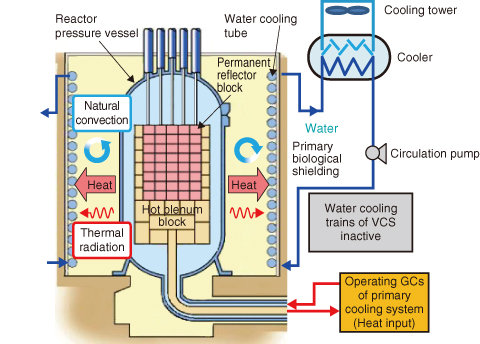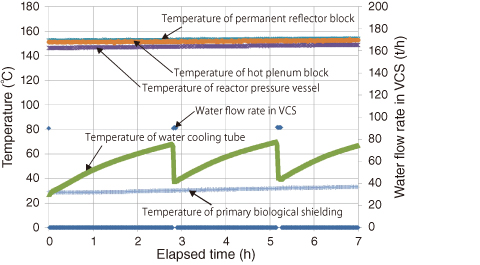
Fig.6-7 Vessel cooling system (VCS)

Fig.6-8 Effectiveness of the method for restricting local temperature rise of the water cooling tube
One of the safety demonstration tests for the HTTR is the loss of forced core cooling test, in which the forced cooling of the reactor core is lost without inserting control rods into the core and cooling by the vessel cooling system (VCS), as shown in Fig.6-7. It will be demonstrated that the HTGR is inherently safe because of natural phenomena within the actual reactor, even if those functions are not available to shut it down or cool it. This makes it possible to design a reactor that is free of severe accidents.
On the other hand, the local temperature of the uncovered cooling tube by the thermal reflector exceeds the limit from viewpoint for long-term use during the test, although the reactor remains safe. This temperature rise can be restricted by restarting the circulation pump for a sufficiently short period of time. However, it is difficult to predict numerically whether restarting the circulation pump would influence the temperatures of reactor internal structures such as a permanent reflector block, because the configuration of the water cooling tubes is complicated.
The reactor cannot be restarted unless the conformity to the new regulation standards is checked. Thus, in order to establish a safe and promising test procedure, a test was conducted using non-nuclear heat input from gas circulators while stopping water flow in the VCS. Multiple thermocouples were set to measure the temperatures of water cooling tubes to specify the position at which the temperature locally increased.
The test results showed the locally increased temperature position, although the temperature was sufficiently lower than the maximum allowable working temperature. On comparing the measured and numerical results, it was found that the local temperature rise of the cooling tube was restricted by starting up the circulation pump for a sufficiently short time (5 min) against the duration period of the test (7 h). On the other hand, the measured temperatures of the permanent reflector blocks, hot plenum blocks, reactor pressure vessel, and primary biological shielding (which were focused on as aspects of safety), were not influenced by the short-term pump restart, as shown in Fig.6-8.
Furthermore, from the results of the flow rate measurement of natural circulation of water by a high-accuracy electromagnetic flow meter, it was found that the natural circulation flow did not have any cooling effect on the temperature of the water cooling tube, because the flow rate increased and then decreased soon after the VCS was stopped.
Through this investigation, a procedure for the loss of forced core cooling test was established, which may be used soon after the restart of HTTR. The safety demonstration test, which shows that the inherent safety of the HTGR can be maintained by natural phenomena, has attracted attention from around the world, and has been conducted as an international joint research project.